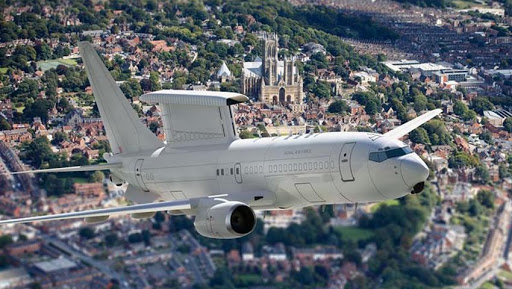The UK’s Marshall Aerospace and Defence Group has confirmed that they have withdrawn from a project to convert five Boeing 737NGs into E-7A Wedgetail surveillance platforms for the Royal Air Force, saying the project was commercially unviable.
To continue reading the rest of this article, please log in.
Create free account to get unlimited news articles and more!
The UK Ministry of Defence in March 2019 signed a £1.5 billion ($1.8 billion) contract with Boeing to replace the RAF’s 707-based E-3D Sentry fleet with five Wedgetail AEW1s. Deliveries are scheduled to occur between 2023 and 2026, with the program’s first two airframes being refurbished second-hand examples sourced from the commercial sector.
“Despite the very best efforts of all parties, we have not been able to find a way to make the program commercially viable for our business,” said Marshall Aerospace and Defence Group chief executive Alistair McPhee.
“As a UK business, we would have been incredibly proud to partner with Boeing to play our part in delivering such an important new platform for the RAF. However, we have to balance that against what is right for the long-term future and financial security of our independent, private company.”
“Our absolute priority now is to continue to support Boeing and the RAF over the coming weeks and months to ensure that the program remains on track,” McPhee says. “We will, of course, collaborate closely with all parties and do whatever we can to effect a smooth and efficient transition.”
Marshall last July said that it expected the Wedgetail conversion work to be performed at its Cambridge airport site to “sustain hundreds of highly skilled jobs in the area”.
STS Aviation Services would now conduct the work after an announcement from Boeing Defence UK. Marshall had been initially awarded a risk-reduction contract last July in support for the effort. A commercial MRO specialist, STS secured the business following a tender process initiated after Marshall’s decision to withdraw its participation.
The UK confirmed in late-2018 that it was in discussion with Boeing and the Royal Australian Air Force about the potential for the E-7 Wedgetail Airborne Early Warning and Control (AEW&C) aircraft to replace its current E-3 Sentry fleet.
The Boeing 737 AEW&C is a state-of-the-art system providing powerful airborne surveillance, communications and battle management.
The 737 AEW&C system encompasses both the Boeing 737-700 aircraft platform and a variety of aircraft control and advanced radar systems. Consisting of components created by Boeing and Northrop Grumman, the 737 AEW&C represents the standard for future airborne early warning systems. The E-7A Wedgetail AEW&C functions include:
- A steerable beam, L-band, electronically scanned array that provides optimal performance in range, tracking and accuracy;
- Radar that can track airborne and maritime targets simultaneously;
- Assistance to the mission crew in directing the control of high-performance fighter aircraft while continuously scanning the operational area;
- A "top hat" portion that provides a practical solution for fore and aft coverage while maintaining the low drag profile of the dorsal array system – enabling the MESA system to be installed on the mid-size 737-700 platform without significant impact to aircraft performance;
- An integrated identification friend or foe (IFF) function that shares the primary radar arrays to reduce weight, improve reliability, and simplify target correlation; and
- Advanced open-system architecture with standards-based design for cost-effective integration and add-on flexibility.
The UK Royal Air Force confirmed in March 2019 that it would pursue the acquisition five E-7A Wedgetail airborne early warning and control aircraft worth US$1.98 billion.
In a statement released at the time of announcement in 2019, a Boeing Defence Australia spokesperson said, "Under the contract, Boeing Defence Australia will support the global Boeing Team in the UK and the US in support of mission system development, ground support segments, and ground-based aircrew and maintenance training."
The Defence Industry minister, now Defence Minister, Linda Reynolds CSC said at the time, "The UK acquisition is expected to deliver 100 jobs to the Brisbane and Newcastle based staff of Boeing Defence Australia, taking advantage of their world-leading capabilities in systems and software engineering and deep experience in Wedgetail support, including ground-based aircrew training.
"Further opportunities – including for the more than 200 Australian companies that have contributed to our own Wedgetail acquisition and sustainment – will be available for Australian industry in the supply chain."
Based at RAAF Base Williamtown, Australia's six E-7A Wedgetails significantly improve the effectiveness of the ADF. They are capable of communicating with other aircraft and providing air control from the sky, and can cover 4 million square kilometres during a single 10-hour mission.

 Login
Login







